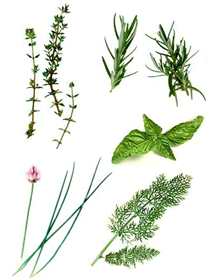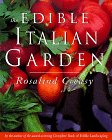your italian herb garden
turn your thumb from brown to green
by Laura Pazzaglia
 Many years ago, in my first apartment, I was given Lavender to put on my balcony. Even though I watered it regularly, the Lavender quickly stopped growing and began it's slow, predictable, death.
Many years ago, in my first apartment, I was given Lavender to put on my balcony. Even though I watered it regularly, the Lavender quickly stopped growing and began it's slow, predictable, death.
When I bought my first house I vowed to flex my thumb to see if it couldn't turn into some shade of green. Italians have along history of growing "kitchen gardens" which goes further back than the Romans. In my determination to reclaim my heritage and grow my own Italian herb garden I read books, and lots of them, and as a result I've been able to have a thriving Italian herb garden for over a year and spot many of my past plant mistakes - which happened even before I brought the plant home!
Find a good spot
Study the area where you're considering starting your herb garden for a few weeks. You'll want to understand what the wind and sun situation is like. Some herbs prefer calm, to windy, areas. Although most herbs need 8 hours of full sun, I found that you can get away with at least 5-6 hours-- usually the more sun the happier and more prolific the herb.
The Dirt on... dirt
If you don't have a patch of dirt, don't fear. Herbs are just as happy in pots - just make sure that the pots aren't plastic (they'll cook-up the roots and dry-up your plant in no time). You may want to consider classic terra cotta pots (orange clay) for your herb garden.
If you do have dirt you'll want to make sure that it has enough nutrients to keep your herbs happy -you don't have to be a dirt-scientist to figure this out. If weeds won't dare set root in the patch� you have problem. Just stop by your local garden center to get some fertilizer or compost to amend the dirt. Spread out a 2-3" inch thick layer of the stuff and start mixing it into the existing dirt with a shovel or hoe.
Baby Plants or seeds?
If you're getting horticultural for the first time, I recommend that you go with baby plants. They provide instant satisfaction and take the guess-work out of when to plant seeds. Most seeds are quite delicate and particular about how and where they start life --if it's too shady, cold or the dirt lacks nutrients you risk getting a small plant that won't live up to it's potential (or flavor).
Pick-up a baby herbs at your local "farmer's market" or garden center starting around March. Tackle seeds next year when you'll be more experienced and adventurous.
Start small
The best advice I read was to start small. Starting small is a sure way to have successful herb garden and gain confidence to make additions to your garden each year. It's easy to get wrapped-up in the enthusiasm of creating an herb garden and come home with a trunk-full of plants that you don't have the experience growing. Starting small gives you the opportunity to get to know each herb intimately, and gives the amateur gardener a realistic patch to maintain.
Choose wisely
Start your garden with herbs that can handle a little neglect. Choose a good mix of annual (plants that die and need to be replanted each year) and perennial (plants that survive for multiple years) herbs. If it snows in your area, check with your local expert to find out if you need to bring-in the perennials in order for them to survive the winter. My sister, who lives in Indianapolis, brings in her Rosemary each winter and decorates it for Christmas!
I started my herb garden with these popular, and forgiving, herbs:
Basil (Ocimum basilicum), annual, needs a sunny spot with fertile soil. An essential ingredient for pesto; use fresh or dried with meat, vegetables, and salads. It's particularly delicious on a Caprese which is a salad of fresh tomatoes, mozzarella and basil with a sprinkle of olive oil. Basil is used to flavor Northern Italian tomato sauces.
Rosemary (Rosmarinus officinalis), perennial, likes medium to rich well-drained soil. In the middle ages, people carried rosemary in their pockets to ward-off evil spirits; today, you'll enjoy adding it to any meat or poultry dish. We particularly enjoy sprinkling fresh Rosemary in a meat marinade of orange juice or wine.
Oregano (Oreganum vulgare), perennial, needs full sun and well-drained soil. It's leaves can be used either fresh or dried -- the flavor seems to be stronger when dry-- in Southern Italian pasta sauces, on top of focaccia or pizza. You can even use Organo's flowers in potpourri!
Sage (Salvia officinalis), perennial, needs full sun and well-drained soil. In Medieval times Sage symbolized immortality, wisdom and longevity; today, you can use the fresh or dried leaves with meat, poultry, or herb vinegar. Make a quick pasta dressing by tossing a few leaves of sage with minced garlic in a bit of olive oil sizzle it all on low for about 5 minutes. It
also goes well with butter on pasta. You can also use Sage to make a tea which is good for indigestion and some kinds of headaches.
In your garden's second year, you may want to expand your Italian herb garden to contain Arugula, Chives, Parsley and try your hand at growing an Italian vegetable or two!
Eating� er harvesting
You'll now be able to add the freshest herbs to your favorite dishes. Here are some tips for getting the best tasting herbs:
- Never harvest more than a third of the plant, you'll want your herb to recuperate and keep on growing.
- Mid-morning, before the afternoon sun, is the time when the herbs are most flavorful (that's because they're not busy converting sunlight to food yet)
- Blooming herbs are busy making a show so their taste may change - usually increasingly bitter. Avoid harvesting them while they flower and, in the case of Basil, cut off the blooms to extend it's lifetime.
Finally, if you cook often with herbs, be sure that your consumption doesn't exceed the supply (death sentence for an herb).
If you still feel like you need more help, or information, I included a list of the books that I've used for my research in the sidebar to this article. You'll find that these will also serve as handy references throughout the life of your garden!



 Many years ago, in my first apartment, I was given Lavender to put on my balcony. Even though I watered it regularly, the Lavender quickly stopped growing and began it's slow, predictable, death.
Many years ago, in my first apartment, I was given Lavender to put on my balcony. Even though I watered it regularly, the Lavender quickly stopped growing and began it's slow, predictable, death.


